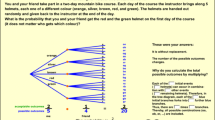Abstract
Learner preferences for varying screen density levels were examined using multiple screen designs (high external validity) and single screen designs (high internal validity). When viewing multiple screens for each design in Study 1, subjects indicated the highest preference for medium-density screens while tending to select higher-density over lower density screens in individual comparisons. When viewing only the first screen of each density level in Study 2, subjects again expressed preferences for higher-density over lower-density designs. Suggestions are provided concerning the use of realistic and nonrealistic content for the stimulus materials as well as implications of using externally and internally valid screen designs for future research on computer-based instruction screen design.
Similar content being viewed by others
References
Allessi, S. M., & Trollip, S. R. (1985).Computer-based instruction: Methods and development. Englewood Cliffs, NJ: Prentice-Hall.
Basset, J. H. (1985).A comparison of the comprehension of chunked and unchunked text presented in two modes: Computer and printed page. Unpublished doctoral dissertation, Memphis State University.
Bork, A. (1984).Personal computers for education. Cambridge, MA: Harper & Row.
Bork, A. (1987).Learning with personal computers. New York: Harper & Row.
Burns, D. (1979). A dual-task analysis of detection accuracy for the case of high target-distractor similarity: Further evidence for independent processing.Perception and Psychophysics, 25, 185–196.
Carver, R. P. (1970). Effect of “chunked” typography on reading rate and comprehension.Journal of Applied Psychology, 54, 288–296.
Coffey, J. L. (1961). A comparison of vertical and horizontal arrangements of alpha-numeric material—Experiment 1.Human Factors, 3, 93–98.
Danchak, M. M. (1976). CRT displays for power plants.Instrumentation Technology, 23, 29–36.
Falio, T., & DeBloois, M. L. (1988). Designing a visual factors-based screen display interface: The new role of the graphic technologist.Educational Technology, 28, 12–21.
Feibel, W. (1984). Natural phrasing in the delivery of text on computer screens: Discussion of results and research approaches. In D. T. Bonnett (Ed.),Proceedings of the Sixth Annual National Computing Conference, Dayton, OH.
Gerrel, H. R., & Mason, G. E. (1983). Computer-chunked and traditional text.Reading World, 22, 241–246.
Grabinger, R. S. (1983).CRT text design: Psychological attributes underlying the evaluation of models of CRT text displays. Unpublished doctoral dissertation, Indiana University.
Guilford, J. P. (1954).Psychometric methods. New York: McGraw-Hill, Inc.
Hays, W. L. (1981).Statistics (3rd ed.). New York: Holt, Rinehart, & Winston.
Heines, J. M. (1984).Screen design strategies for computer-assisted instruction. Bedford, MA: Digital Press.
Hooper, S., & Hannafin, M. J. (1986). Variables affecting the legibility of computer generated text.Journal of Instructional Development, 9, 22–29.
Mackworth, N. H. (1976). Stimulus density limits the useful field of view. In R. A. Monty & J. W. Senders (Eds.),Eye movements and psychological processes. Hillsdale, NJ: Lawrence Erlbaum.
Morrison, G. R., Ross, S. M., & O'Dell, J. K. (1988). Text density level as a design variable in instructional displays.Educational Communication and Technology Journal, 36, 103–115.
NASA. (1980).Spacelab display design and command usage guidelines (Report MSFC-PROC-711A). Huntsville, AL: George Marshall Space Flight Center.
Nunnally, J. C. (1967).Psychometric theory. New York: McGraw-Hill.
O'Shea, L. T., & Sinclair, P. T. (1983). The effects of segmenting written discourse on the reading comprehension of low- and high-performance readers.Reading Research Quarterly, 18, 458–465.
Ringel, S., & Hammer, C. (1964).Information assimilation for alphanumeric displays: Amount and density of information presented (Tech. Report TRN141). Washington, DC: U.S. Army Personnel Research Office (NTIS No. AD 6021 973).
Ross, S. M. (1983).Introductory statistics: A conceptual approach. Danville, IL: Interstate Printers & Publishers.
Ross, S. M., & Morrison, G. R. (1989). In search of a happy medium in instructional technology research: Issues concerning external validity, media replications, and learner control.Educational Technology Research and Development, 37(1), 19–33.
Ross, S. M., Morrison, G. R., & O'Dell, J. K. (1988). Obtaining more out of less text in CBI: Effects of varied text density levels as a function of learner characteristics and control strategy.Educational Communication and Technology Journal, 36, 131–142.
Smith, S. L. (1980).Requirements definition and design for the man-machine interface in C 3 system acquisition (Technical Report ESD-TR-80-122). Bedford, MA: USAF Electronic Systems Division (NTIS No. AD A087 528).
Smith, S. L. (1981).Man-machine interface (MMI) requirements definition and guidelines: A progress report (Technical Report ESD-TR-81-113). Bedford, MA: USAF Electronic Systems Division (NTIS No. AD A096 705).
Smith, S. L. (1982).User-system interface design for computer-based information systems (Technical Report ESD-TR-82-132). Bedford, MA: USAF Electronic Systems Division (NTIS No. AD A115 853).
Sticht, T. (1985). Understanding readers and their uses of text. In T. M. Duffy & R. Waller (Eds.),Designing useable texts (pp. 315–340). Orlando, FL: Academic Press.
Tullis, T. S. (1983). The formatting of alphanumeric displays: A review and analysis.Human Factors, 25, 657–682.
Twyman, M. (1981). Typography without words.Visible Language, 15, 5–12.
Author information
Authors and Affiliations
Rights and permissions
About this article
Cite this article
Morrison, G.R., Ross, S.M., Schultz, C.W. et al. Learner preferences for varying screen densities using realistic stimulus materials with single and multiple designs. ETR&D 37, 53–60 (1989). https://doi.org/10.1007/BF02299056
Issue Date:
DOI: https://doi.org/10.1007/BF02299056




